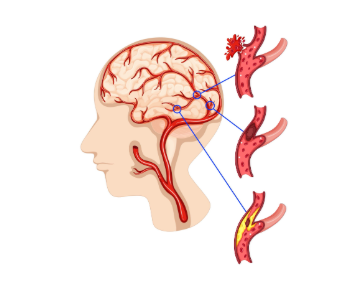By : Geraldus Sigap

Do not ignore sudden headaches that feel different from usual. Recently, several public figures have tragically passed away due to ruptured brain aneurysms, reminding us that this silent threat can affect anyone, at any time. A brain aneurysm is a serious condition that often goes undetected until it is too late.
What Is a Brain Aneurysm?
A brain aneurysm is a bulging or ballooning of a blood vessel in the brain due to weakness in the vessel wall, most commonly affecting adults over the age of 40. If left undetected and it ruptures, it can cause bleeding in the brain (subarachnoid hemorrhage), which can be fatal. This condition is often called a “silent killer” because it can develop without symptoms until it ruptures.
Symptoms of a Brain Aneurysm to Watch For
Most small aneurysms cause no symptoms. However, larger or ruptured aneurysms can present the following signs:
- A sudden, severe headache that feels like a “burst” in the head
- Nausea and vomiting
- Stiff neck
- Blurred or double vision
- Drooping eyelid
- Seizures
- Sudden loss of consciousness
If you or someone close to you experiences any of these symptoms, seek medical help immediately!
What Causes a Brain Aneurysm?
The exact cause of brain aneurysms is not fully known, but several risk factors may increase the likelihood:
- High blood pressure (hypertension)
- Smoking
- Family history of brain aneurysms
- Age over 40
- Gender (more common in women)
- Certain medical conditions such as connective tissue disorders (e.g., Ehlers-Danlos syndrome)
How Is It Detected?
Early detection is key to preventing rupture. The initial screening may involve a CT scan or MRI to visualize brain structures and detect abnormalities. If an aneurysm is suspected, the diagnosis is confirmed through Digital Subtraction Angiography (DSA), which provides the most detailed view of blood vessels and is considered the gold standard for detecting brain aneurysms.
- CT Scan or MRI: To view brain and blood vessel structures.
- CT Angiography or MRA (Magnetic Resonance Angiography): To detect vessel enlargement.
- Digital Subtraction Angiography (DSA): The most accurate test for detecting brain aneurysms.
Treatment for Brain Aneurysms
Treatment depends on the size, location, and whether the aneurysm has ruptured. Options include:
- Endovascular Coiling
- A minimally invasive procedure where a catheter is inserted into the blood vessel to seal off the aneurysm from the inside.
- Aneurysm Clipping
- An open surgery using a metal clip to close off the aneurysm and stop blood flow into it.
- Routine Monitoring
- If the aneurysm is small and unruptured, the doctor may recommend regular imaging and blood pressure control.
Can Aneurysms Be Prevented?
While not entirely preventable, you can reduce your risk by:
- Controlling blood pressure
- Quitting smoking
- Avoiding excessive alcohol intake
- Maintaining a healthy diet and regular exercise
- Getting regular check-ups, especially with a family history
When to See a Doctor
Don’t wait until it’s too late. If you experience a sudden, severe headache, vision changes, or any neurological symptoms, consult a neurologist immediately for further examination. Our medical team is ready to help you detect and manage brain aneurysms early. Visit RS Abdi Waluyo or make an appointment at 021-3144989.
FAQ
What’s the difference between a brain aneurysm and a stroke?
An aneurysm is a bulging blood vessel that can rupture and cause a hemorrhagic stroke. Stroke can also be caused by blockage (ischemic).
Can a brain aneurysm be completely cured?
Yes, if it’s unruptured and treated promptly with coiling or clipping. If ruptured, the outcome depends on how quickly it is treated.
Can a brain aneurysm be detected early?
Yes. Through CT angiography, MRI, or DSA, especially if risk factors are present.
Does every headache mean an aneurysm?
No. But sudden, severe headaches that feel different from usual should be taken seriously.
Who is at risk for brain aneurysms?
Smokers, people with hypertension, women, those over 40, or those with a family history of aneurysms.
Can aneurysms be prevented?
Not completely, but the risk can be lowered through a healthy lifestyle and blood pressure control.
Resource :
- Toth G, Cerejo R. Intracranial aneurysms: Review of current science and management. Vasc Med Lond Engl 2018;23(3):276–288.
- Bekelis K, Goodney PR, Dzebisashvili N, Goodman DC, Bronner KK. Cerebral aneurysms: frequency and variation [Homepage on the Internet]. In: Variation in the Care of Surgical Conditions: Cerebral Aneurysms: A Dartmouth Atlas of Health Care Series [Internet]. The Dartmouth Institute for Health Policy and Clinical Practice, 2014 [cited 2025 May 6]; Available from: https://www.ncbi.nlm.nih.gov/books/NBK586759/
- Jersey AM, Foster DM. Cerebral Aneurysm [Homepage on the Internet]. In: StatPearls. Treasure Island (FL): StatPearls Publishing, 2025 [cited 2025 May 6]; Available from: http://www.ncbi.nlm.nih.gov/books/NBK507902/
